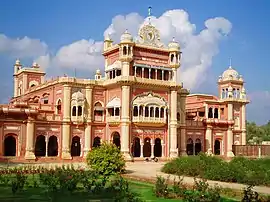Talpur dynasty
The Talpur dynasty (Sindhi: ٽالپردور) were rulers based in Sindh, a region of present-day Pakistan. Four branches of the dynasty were established following the defeat of the Kalhora dynasty at the Battle of Halani in 1783: one ruled lower Sindh from the city of Hyderabad, another ruled over upper Sindh from the city of Khairpur, a third ruled around the eastern city of Mirpur Khas, and a fourth was based in Tando Muhammad Khan. The Talpurs were ethnically Baloch.
Talpur dynasty ٽالپردور | |||||||||||
|---|---|---|---|---|---|---|---|---|---|---|---|
| 1783–1843 | |||||||||||
 Flag | |||||||||||
 Talpur dynasty in 1823 before annexation by British, Khairpur was later carved out as a British vassal state | |||||||||||
| Capital | Hyderabad, Khairpur, and Mirpur Khas | ||||||||||
| Religion | Shia Islam | ||||||||||
| Government | Nobility (Mirs) | ||||||||||
| History | |||||||||||
• Established | 1783 | ||||||||||
• continued in upper Sindh as the Khairpur princely state until 1955 | 1843 | ||||||||||
| |||||||||||
| Today part of | Sindh, Pakistan | ||||||||||
| History of Sindh |
|---|
 |
| History of Pakistan |
| History of Pakistan |
|---|
 |
| Timeline |
|
For most of their rule, they were subordinate to the Durrani Empire and were forced to pay tribute to them.[1][2]
They ruled from 1783, until 1843, when they were in turn defeated by the British at the Battle of Miani and Battle of Dubbo.[3] The northern Khairpur branch of the Talpur dynasty, however, continued to maintain a degree of sovereignty during British rule as the princely state of Khairpur, whose ruler elected to join the new Dominion of Pakistan in October 1947 as an autonomous region, before being fully amalgamated into West Pakistan in 1955.
History

The Talpurs were ethnically Sindhi-speaking Baloch,[4] and were descendants of Mir Sulaiman Kako Talpur, who had arrived in Sindh from Choti Bala in southern Punjab.[5] The former rulers, the Kalhoros, had a large number of disciples from the Balochs of Dera Ghazi Khan and the Jatts of Southern Punjab, who had gained jagirs in Sindh.[6] The Talpurs had served the Kalhora dynasty until 1775, when the Kalhora ruler had ordered the assassination of the chief of the Talpur clan, Mir Bahram Khan, leading to a revolt among the Talpurs against the Kalhora crown. Mir Shahdad Khan Talpur, the great grandfather of the founder of the Talpur dynasty, was a Mughal bureaucrat, and established the city of Shahdadpur in 1713.[7]
The Talpur dynasty was established in 1783 by Mir Fateh Ali Khan Talpur, who declared himself the first Rais, or ruler of Sindh, after defeating the Kalhoras at the Battle of Halani. Early Talpur rule was termed the First Chauyari, or "rule of four friends" - Mir Fateh along with his brothers Mir Ghulam, Mir Karam, and Mir Murad.[8] The Talpur capital was declared to be Hyderabad, which had served as the capital of the overthrown Kalhoras. After his success, Fateh Ali Khan ruled from Hyderabad, while his nephew established a branch of the dynasty in Khairpur. Another relative, Mir Thara Khan, established the Mankani branch in southeast Sindh around the area around Mirpur Khas - a city which was founded by his son Ali Murad Talpur.
The Talpur brothers extended their rule over neighboring regions such as Balochistan, Kutch, and Sabzalkot, covering an area of over 100,000 square kilometers, with a population of approximately 4 million. They administered their realm by assigning jagirs to control individual land grants. In 1832, Afghan king Shah Shuja invaded Sindh, which the brother united against to defeat. During their rule, Syed Ahmad Barelvi tried to garner support for a campaign against the Sikh emperor Ranjit Singh, but was perceived to be a British agent. Divisions among the Talpurs, such as the Khairpur chiefs request to the British to seize Karachi from the Hyderabadi chiefs, allowed the British to eventually conquer Sindh. The British conquered Karachi in 1839, and with the support of Khojas and Hindus, were able to quickly advance on Hyderabad, forcing the Talpurs to pay tribute. Seth Naumal, a Hindu merchant, was held responsible by the Talpurs for encouraging non-Baloch tribes in lower Sindh to defect and aid the British. He was later granted the title Sitara-e-Hind by the British for his service to them against the Talpurs.[8]
Religious beliefs

The Talpurs were followers of the Shia sect of Islam. Under their rule in both Hyderabad and Khairpur, Shia practices such as the building of Shabeeh and Zareeh Mubarak, or replicas of shrines of Shia Imams, were established. The first was built at Tando Agha in Hyderabad in 1785 by the founder of the Talpur dynasty, Mir Fateh Ali Khan. The Qadamgah Imam Ali was established in Hyderabad during his rule, and houses what are considered by the faithful to be the footprint of Imam Ali, and were gifted to Mir Fateh Ali Khan by the Shah of Persia, Fath Ali Khan Qajar. The footprints were housed in a special shrine for the Talpur family, and were viewed by the public on certain holidays. Under the rule of the last Hyderabadi Talpur Mir, Naseer Khan, a new shrine was made in which the footprints were made accessible to the public. Other Shia replica shrines were eventually built by other Talpur rulers in several cities and towns in Sindh. These replicas were built for the poor who did not have resources to travel to the actual shrines in Iraq and Iran, and continue to operate until present day.[9]
Branches
Shahdadani Talpurs of Hyderabad

The Talpur dynasty was established in 1783 by Mir Fateh Ali Khan, who declared himself the first Rais, or ruler of Sindh, after defeating the Kalhoras at the Battle of Halani. He ruled until his death in 1801, when he was succeeded by his son Mir Ghulam Ali Talpur until 1811. From 1811 to 1828, the Hyderabadi Talpur state was ruled by Mir Karam Ali Talpur. After his death in 1828, The Hyderabad branch of the Talpurs was ruled by Mir Murad Ali Khan until 1833. Mir Murad Ali Khan was succeeded by Mir Noor Muhammad, who was in turn succeeded by Mir Naseer Khan Talpur. The Hyderabadi branch of the Talpur Mirs were defeated by the British at the Battle of Miani on 17 February 1843.
Sohrabani Talpurs of Khairpur

The Talpur dynasty was established in 1783 by Mir Fateh Ali Khan, who declared himself the first Rais, or ruler of Sindh, after defeating the Kalhoras at the Battle of Halani. The nephew of Mir Fateh Ali Khan, Mir Sohrab Khan Talpur, established a branch of the Talpur dynasty in 1783 in Burahan, which was renamed Khairpur in 1783. The Khairpur branch of the dynasty maintained a degree of sovereignty during British rule as the princely state of Khairpur until 1947. The death of Mir Sohrab Khan Talpur, founder of the Khairpur branch abdicated power to his eldest son Mir Rustam 'Ali Khan, in 1811. Rustam's youngest half brother, 'Ali Murad, strengthened his hand by signing a treaty with the British in 1832, in which he secured recognition as the independent ruler of Khairpur in exchange for surrendering control of foreign relations to the British, as well as use of Sindh's roads and the Indus River. The new state's economy became heavily dependent upon the production of opium.[10]

Rustam ruled until 1842, when he in turn was replaced by Mir Ali Murad. Ali Murad helped the British in 1845 during the Turki campaign, but was later accused of plotting against the British, and so was stripped of his lands in upper Sindh. The remaining land under his control consisted mostly of Khairpur city, and its immediate environs. During the 1857 Sepoy Mutiny, Ali Murad sided which the British, and prevented rebels from seizing the Shikarpur jail and treasury. In 1866, the British promised to recognize any future successors as rightful rulers of Khairpur. Ali Murad's rule went on uninterrupted until his death in 1894.
Ali Murad was succeeded by his second son, Mir Faiz Muhammad Khan, who died in 1909. He was in turn succeeded by his son, Mir Sir Imam Bakhsh Khan Talpur, who aided the British war effort during World War I, and was thus awarded the honorary title Lieutenant-Colonel in 1918. He died in 1921, and was succeeded by His Highness Mir Ali Nawaz Khan. Under his rule, the feudal Cherr system of forced labour was abolished, while new canals were laid for irrigation.
Mir Ali Nawaz Khan died in 1935, and was succeeded by Mir Faiz Muhammad Khan II, who had suffered from an unstable and nervous affliction, then became nominal leader. The Khairpur government instituted a council of regency under local ministers and ordered the Mir to live outside the state. After a period of twelve years, and shortly before the transfer of power, he abdicated in favour of his minor son in July 1947. The state acceded to the Dominion of Pakistan in October that year, and merged into West Pakistan in 1955.
Manikani Talpurs of Mirpur Khas
Mir Thara Khan, a relative of the Talpur founder Mir Fateh Ali Khan Talpur, established the Manikani branch in southeast Sindh around the area around Mirpur Khas - a city which was founded by his son Ali Murad Talpur.

Mir Sher Muhammad Talpur succeeded Mir Ali Murad Talpur in 1829, and built a fort in the city when he declared the ruler of the state, and ran a kutchery from within the fort. Elaborate graves for the local rulers were built at Chitorri under his rule. and feature a syncretic architectural style that combines elements of Islamic and Rajasthani architecture.[11] Mir Sher Muhammad Talpur established friendly relations with the Sikh emperor Ranjit Singh, but fought against the British. He has been described as the "Lion of Sindh."[12]
Mirpur Khas remained the capital of the Talpur Mirs of Mirpurkhas until 1843, when Sindh was annexed to British India under the East India Company following the conquest of Sindh by Charles James Napier and defeat of Mir Sher Muhammad Talpur on 24 March 1843 at the battleground of Dubbo. During the battle, some local Sindhi jagirs are reported to have taken bribes from British forces, and aimed their guns towards Talpur forces. Following British victory, the chief's harem was entered, and its women plundered of their jewelry before being imprisoned.[8]
Shahwani Talpurs of Tando Muhammad Khan
The Shahwani branch of the Talpur dynasty was established by Mir Muhammad Khan Talpur Shahwani, who died in 1813. Under his rule, the city of Tando Muhammad Khan was established.
See also
References
- Baloch, Inayatullah (1987). The Problem of "Greater Baluchistan": A Study of Baluch Nationalism. Steiner Verlag Wiesbaden. p. 121. ISBN 9783515049993.
- Ziad, Waleed (2021). Hidden Caliphate: Sufi Saints Beyond the Oxus and Indus. Harvard University Press. p. 53. ISBN 9780674248816.
- "The Royal Talpurs of Sindh - Historical Background". www.talpur.org. Retrieved 2020-02-23.
- Belkacem Belmekki, Michel Naumann (2022). Paradoxes ofPakistan: A Glimpse. Columbia University Press. p. 28. ISBN 9783838216034.
- Journal of Asian Civilisations:Volume 30, Issue 2. Taxila Institute of Asian Civilisations. 2007. p. 71.
The father of Mir Manik Khan Talpur , Mir Suleman Khan Talpur alias Kako Khan migrated from Choti Bala in Punjab
- Syed Khundniri (2013). Muqaddama-E-Sirajul Absar:Volume 2. p. 1134. ISBN 9781490708249.
- Schimmel, Annemarie (1980). Islam in the Indian Subcontinent. BRILL. ISBN 978-90-04-06117-0.
- Pathan, Mumtaz Husain (2017). Talpurs in Sindh, 1783-1843. Endowment Fund Trust. ISBN 978-969-9860-11-9.
- Mukherjee, Tarun Tapas; Mukherjee, Sreecheta (2015-08-01). Chitrolekha International Magazine on Art and Design, Volume 5, Number 2, 2015. Chitrolekha International Magazine on Art and Design.
- Eaton, Richard M.; Faruqui, Munis D.; Gilmartin, David; Kumar, Sunil; Richards, John F. (2013-03-07). Expanding Frontiers in South Asian and World History: Essays in Honour of John F. Richards. Cambridge University Press. ISBN 978-1-107-03428-0.
- "Royal palaces of Talpurs of Mirpurkhas". Sindh Times. 17 April 2015. Retrieved 20 December 2017.
- The kutchery in the fort now has a tablet embedded at the entrance reading, "The fort within which this building stands was residence of Mir Sher Muhammad Khan, the Lion of Sind."